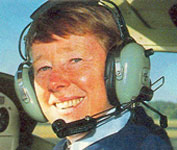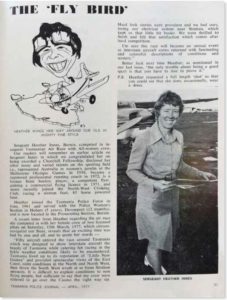Paving the way for change
Heather Innes was the first Australian woman to head a drug bureau, the second woman to be appointed to the rank of Inspector in Tasmania, was the state’s only police pilot, and even competed in the 1956 Olympics in javelin.
Heather Innes was a trailblazer for women in policing in the 60s, 70s and 80s – breaking through the glass ceiling to senior roles within Tasmania Police. She helped pave the way for dramatic changes in the dress code to allow for a more practical uniform and instigated the inaugural Police Women State Conference.
Today, Heather continues to inspire police officers, both men and women, despite retiring nearly 30 years ago.
Born in 1939 in Smithton, Tasmania, Heather joined Tasmania Police in 1961 as an Auxiliary Constable and was stationed in Hobart.
“I had to wait until I was 21 and even then I couldn’t join as a Constable as women couldn’t become Constables until they were 25.
“I got paid next to nothing and didn’t even have a badge number. After 12 months I became a Special Constable but I still didn’t have a number and the boys used to call me Special Constable No Number Innes,” she recalled with a laugh.
As a woman Special Constable, Heather got 75% of the Special Constables’ wage.
“We were looked on as welfare officers – working with neglected children, dealing with family issues and sexual offences.”
However Heather’s investigative abilities shone through and very early on she was helping Hobart CIB solve several outstanding cases.
“I was looking for a missing girl and when I found her, I searched the place and found all this stuff from a chemist shop break-in, so the CIB was able to clean that case up.”
This was an old-fashioned era when women had to resign if they got married, and policemen had to ask permission of the Commissioner to get married.
“In fact one of our jobs when I first started was interviewing the prospective wives to see if we thought they were good enough! So the men were a bit scrutinised as well,” Heather said.
As an unmarried woman, Heather was able to gain vital experience relieving in Burnie, Launceston and Queenstown.
“I had to wait four years to become a Special Constable and then I had to wait another four years before I could sit the Sergeant’s course, so I was in the job for about nine years before I could actually sit for any promotion,” she said.
“I was very slow to climb up the ranks. Being equal wasn’t good enough, but it was the same for the other women trying to go up the scale. I didn’t find any issues with my male work-mates, it was the system at the time.”
Heather missed out on a Sergeant’s position in Burnie so took the matter to the Appeals Tribunal.
“They told me I didn’t get it because they didn’t want an unmarried Sergeant. I quoted them about three other unmarried male Sergeants, but apparently that was different.”
Things slowly started to change. Equal pay came in the 1970s, followed by practical changes to the uniform for police women.
In 1976, Heather was awarded a Churchill Fellowship to travel overseas to undertake a contrasting study in England, Scotland and Scandinavia on enforcement of moral laws. On her return, she used the information to develop procedures for police personnel to deal with child abuse, rape and child pornography.
She also brought back with her a cap that was used by Manchester Police: Heather was determined to make a few changes to the uniform.
“They were the perfect type of cap to wear, you couldn’t get hit over the head with them or hurt by them, so we managed to get the caps to be part of our uniform,” she said.
“Over time we got a plain clothes allowance and we were able to change the shoes. Previously we had to wear high heeled shoes, so you can imagine what that was like trying to run after crooks in high heels!
“We also introduced a black skirt and a white shirt, and then we were allowed to wear slacks.
“I said I couldn’t wear a skirt and stockings while flying the plane, and I needed to be able to wear slacks, so they let me. Over time it progressed to other women working
in other areas. We made little chinks in their armour, bit by bit.”
Heather also instigated a Policewomen’s Conference for all the policewomen around the state in the 1980s.
“We put all our recommendations to the Commissioner as to how we could improve things. We were listened to, albeit the changes were a bit slow. That was another first and a really good step forward for women in Tasmania Police.”
Heather says that while milestones like equal pay and conditions, and uniform changes have levelled the playing field for women in Tasmania Police, policing was no easy gig for women those days.
“Women are expected to do the exact same work now by fronting up on their beat work, which can be hard and physically demanding – but absolutely rewarding,” she said.

Above: Heather featured in a 1977 Tasmania Police Journal.



